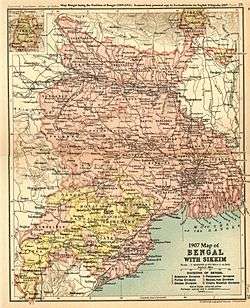Santhal Pargana division

Santhal Pargana division constitutes one of the five administrative units known as the divisions of Jharkhand state in eastern India.
Origin of name

Santhal Pargana derives its name from two words: "Santhal", a major tribe of India and "Pargana", a Persian word meaning "district."
Location
Santhal Pargana is one of the divisions or commissionaries of Jharkhand. Its headquarters is at Dumka. Presently, this administrative division comprises six districts: Godda, Deoghar, Dumka, Jamtara, Sahibganj and Pakur.

History
Formerly, Santhal Parganas comprised a district of the same name, in undivided Bihar state, India. Earlier to that, in 1855, during British India, Santhal Parganas was created as a district, and was a part of the Bengal Presidency.
Mahabharat period

In Mahabharat period, this Santhal Pargana area was part of Anga Mahajanpad along with the parts of Bhagalpur division. The capital of Anga was Champā (Bhagalpur). According to the Mahabharata, Duryodhana had named Karna the King of Anga.
Kajangala
This region is mentioned as Kajangala in different ancient literatures specially in Buddhist literatures. It is mentioned that the Chinese monk-traveller Xuanzang (Hiuen Tsang) travelled from Champa (recent Bhagalpur) to Kajangala and then proceeded to Pundravardhana(recent Bangladesh) in the 7th century AD. He says that the northern limit of its territory(means Sahebganj) was not very far from the Ganges. The forests to the south had plenty of elephants. The people were straight forward, talented and devoted to education.[1]
Santhal rebellion

Santhal Pargana is main land of famous Santhal rebellion. On 30 June 1855, two Santal rebel leaders, Sidhu and Kanhu Murmu, mobilized ten thousand Santals and declared a rebellion against British colonists.[2][3]
Languages
Hindi is official language of Santhal Pargana. A variety of other languages are spoken in this region. Bengali, Santali, Bhojpuri, Nagpuri, Angika( a dialect of Maithili) are mostly spoken in this region. Santali language is one of the most spoken language by local tribes. Number of Bengali is also significant as already mentioned that Santhal Pargana was a part of Bengal. Later on, Santhal Pargana became part of Bihar so number of Bihari speakers like Bhojpuri are also considerable.
References
- ↑ Roy, Niharranjan, Bangalir Itihas, Adi Parba, (in Bengali), first published 1972, reprint 2005, pp. 99-100, 81-93, Dey’s Publishing, 13 Bankim Chatterjee Street, Kolkata, ISBN 81-7079-270-3
- ↑ http://sahibganj.nic.in/en/History.html
- ↑ http://wesanthals.tripod.com/id50.html